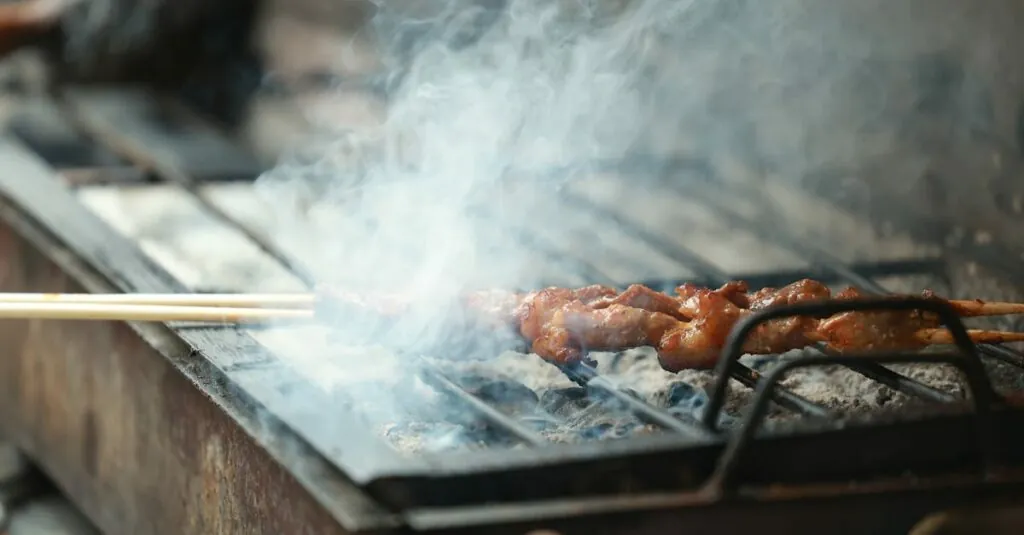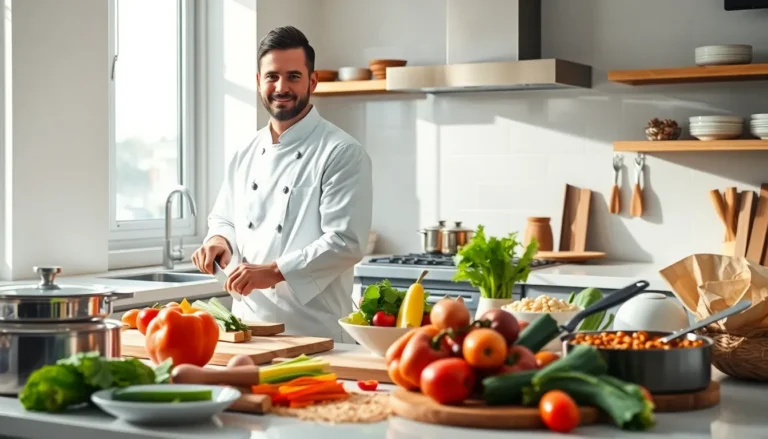Table of Contents
ToggleWhen it comes to cooking meat, most folks fall into one of two camps: the grill masters who swear by their charcoal and the oven enthusiasts who think broiling is the pinnacle of culinary genius. But what if there’s a whole world of meat cooking techniques waiting to be explored? From sous vide to smoking, each method offers a unique flavor profile and texture that can elevate any dish from mundane to mouthwatering.
Overview of Meat Cooking Techniques
Cooking meat involves various techniques that enhance flavor and texture. Grilling stands out, boasting high heat and quick cooking times, which creates a perfect sear on meats. Smokers infuse meat with rich flavors over extended cooking periods, allowing for tender results.
Oven roasting offers another approach. It maintains a consistent temperature that promotes even cooking and caramelization. Sous vide, a modern method, requires vacuum-sealing meat and cooking it in temperature-controlled water, ensuring perfect doneness.
Braising combines moisture and low heat. This technique effectively tenderizes tougher cuts by simmering them in liquid for extended periods. Pan-searing delivers a crust while preserving juiciness, perfect for steaks or pork chops.
Stir-frying cooks meat quickly in a wok over high heat, often accompanied by vegetables. This method ensures a crispy texture while retaining flavor. Conversely, poaching gently cooks meat in simmering liquid, producing tender results ideal for chicken and fish.
Pressure cooking speeds up the cooking process while retaining moisture. This technique significantly reduces cooking time for tougher cuts. Each method contributes uniquely to meat’s flavor profile, enriching the overall culinary experience.
Exploring various meat cooking techniques introduces new flavors and textures. Experimenting with these methods can elevate everyday meals. Chefs and home cooks alike benefit from understanding these diverse approaches to meat preparation.
Dry Heat Cooking Methods
Dry heat cooking methods utilize high temperatures to create flavorful dishes. Popular techniques include roasting, grilling, and broiling.
Roasting
Roasting involves cooking meat in an oven at high temperatures. This method ensures even cooking while promoting caramelization. Chefs often use this technique for whole cuts like poultry or beef. Vegetables can roast alongside the meat, allowing for complementary flavors. Ideal temperatures range between 375°F and 450°F, enhancing the final texture and taste. When properly seasoned, roasted meats develop a delicious crust, locking in moisture.
Grilling
Grilling cooks meat quickly over direct heat, often using charcoal or gas grills. This method imparts distinctive smoky flavors while achieving a desirable char on the surface. Meats like steaks, burgers, and chicken breast shine when grilled. Maintaining high temperatures allows for quick cooking, preserving juiciness inside. It’s essential to preheat the grill for optimum results. Grilling also encourages outdoor dining, adding to the overall experience.
Broiling
Broiling exposes meat to direct heat from above, similar to upside-down grilling. This technique works well for tender cuts such as steaks or chops. The oven’s broiler achieves high temperatures, making it possible to cook meat quickly. Shedding excess fat while broiling results in a healthier dish. Positioning the meat close to the heat source ensures proper cooking and browning. Monitoring the process prevents overcooking, allowing for flavorful, tender meat dishes.
Moist Heat Cooking Methods
Moist heat cooking methods use liquid or steam to tenderize meat, resulting in flavorful dishes. Techniques like braising, stewing, and poaching provide distinct flavors and textures.
Braising
Braising combines both dry and moist heat techniques to tenderize tougher cuts of meat. First, brown the meat in a pan for added flavor. After browning, add liquid such as broth, wine, or water. Cover and cook slowly at low temperatures, allowing the meat to absorb the flavors. The process typically takes several hours, transforming cuts like chuck roast or brisket into tender, juicy meals. Braising enhances the meat’s richness while breaking down tough fibers effectively.
Stewing
Stewing involves cooking small, uniform pieces of meat submerged in liquid. This technique works best with tough cuts that benefit from prolonged cooking. Start by searing the meat to enhance flavor, then add vegetables and spices. Once combined, add enough liquid to cover and simmer. Cooking on low heat for two to three hours breaks down tough connective tissues, resulting in a hearty, flavor-packed dish. Stews often present the opportunity to incorporate seasonal vegetables, creating a balanced meal.
Poaching
Poaching gently cooks meat in simmering liquid, ensuring tenderness without added fats. Using water, broth, or wine, the liquid should be heated just below boiling. This method suits delicate proteins like fish or poultry. For optimal results, season the poaching liquid with herbs and spices, enhancing the dish’s flavor. The gentle heat keeps the meat moist and succulent, retaining its natural flavors while preventing overcooking. Poaching offers a versatile way to prepare lighter dishes while focusing on healthy cooking methods.
Combination Cooking Techniques
Combination cooking techniques blend both dry and moist heat methods, enhancing flavors and textures in meat dishes. These approaches create opportunities for chefs to experiment and achieve perfect results.
Sous Vide
Sous vide cooking involves sealing meat in a vacuum-packed bag and immersing it in precisely controlled water. Temperatures typically range from 130°F to 160°F, depending on the desired doneness. This method ensures that meat cooks evenly throughout, resulting in consistent tenderness. Chefs appreciate sous vide for its ability to enhance flavors without drying out the meat. Many prefer using this technique for steaks, pork chops, or chicken breasts, benefiting from its convenience and unmatched precision.
Pressure Cooking
Pressure cooking intensifies flavors while significantly reducing cooking time. By trapping steam in a sealed pot, temperatures can reach 250°F, allowing tougher cuts of meat to become tender in a fraction of the time. This method works well for stews, roasts, and braised meats, making it a favorite among busy cooks. Along with retaining moisture, pressure cooking helps achieve rich flavors through the Maillard reaction. Many chefs utilize this technique to prepare hearty meals quickly, allowing for effortless weeknight dinners while ensuring that meals remain flavorful and satisfying.
Tips for Perfectly Cooked Meat
Achieving perfectly cooked meat requires attention to detail and the right techniques. Use a reliable meat thermometer to check internal temperatures; this ensures the desired doneness without guesswork. Letting meat rest after cooking allows juices to redistribute, resulting in a more flavorful and moist bite.
Choose the right cut for the chosen cooking method. Tough cuts benefit from slow cooking methods like braising, while tender cuts shine when grilled or pan-seared. Season meat adequately before cooking to enhance its flavors; dry rubs or marinades add depth and complexity.
Maintain proper temperatures while cooking. For example, searing meat at high heat creates a desirable crust, while lower temperatures promote even cooking in larger cuts. Using a two-zone setup on the grill allows for both direct and indirect cooking, maximizing flavor and texture.
Consider using wood chips when smoking for added flavor. Experiment with different types of wood, such as hickory or apple, to complement the meat. Additionally, incorporate herbs and spices to elevate seasonal dishes; freshly chopped rosemary or thyme can enhance aromas and taste.
Marinating meat not only adds flavor but also tenderizes it. Acids like vinegar or citrus juices break down proteins, making meat more succulent. Apply the right marinade for the right duration; longer marinating for tougher cuts typically yields better results.
Understand the timing for each cooking method to avoid overcooking. Following suggested cooking times based on weight and type will lead to more consistent outcomes. Balancing cooking techniques with patience makes a significant difference in achieving perfectly cooked meat for meals.
Exploring various meat cooking techniques opens up a world of flavors and textures. Each method offers unique benefits that can elevate any dish. From the smoky allure of grilling to the precision of sous vide cooking, the options are vast.
Experimenting with different techniques not only enhances culinary skills but also encourages creativity in the kitchen. Whether it’s the tenderness achieved through braising or the quick sear from pan-frying, mastering these methods can lead to mouthwatering results.
Ultimately, the key lies in understanding the meat and the cooking process, allowing for perfectly cooked meals that delight the palate. Embrace these techniques and enjoy the journey of transforming simple cuts into unforgettable dishes.



